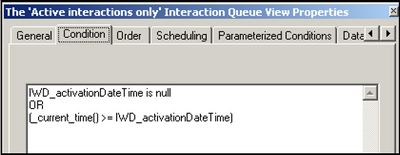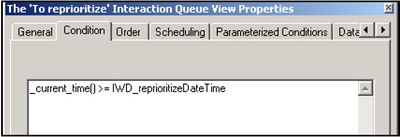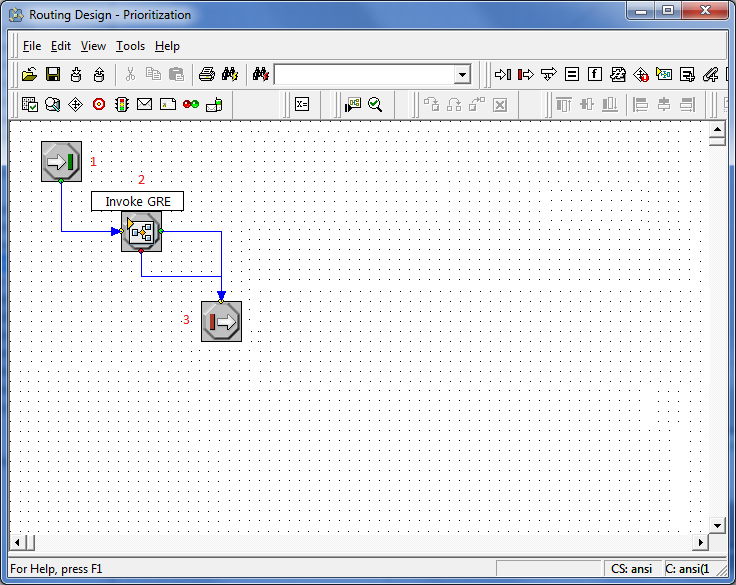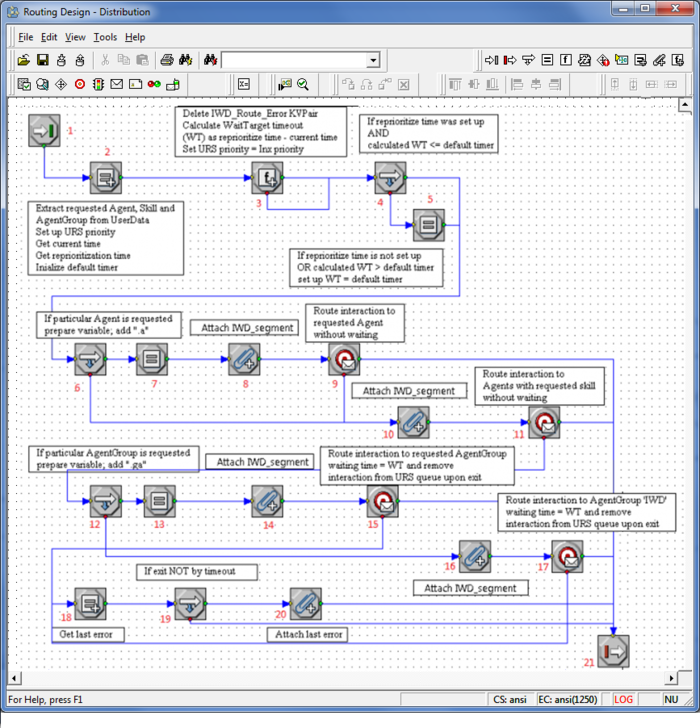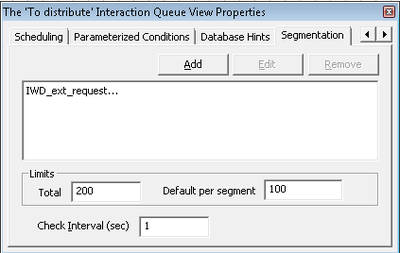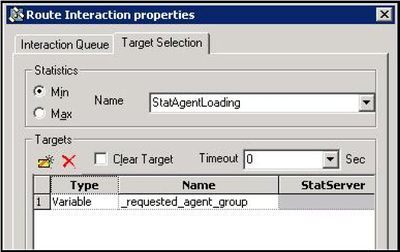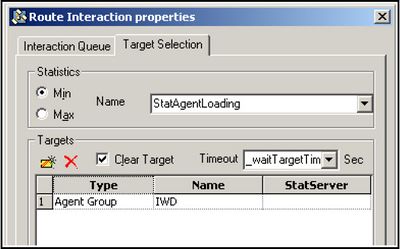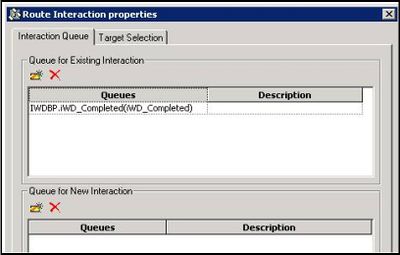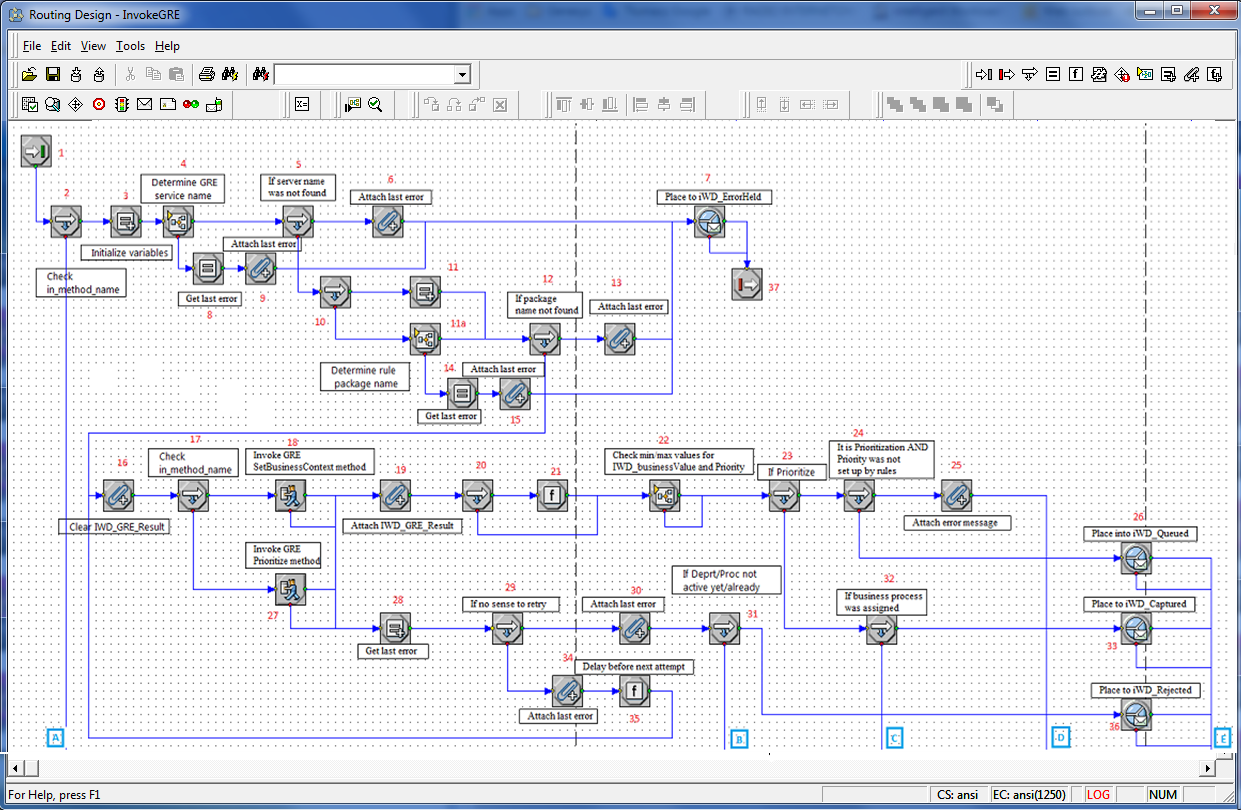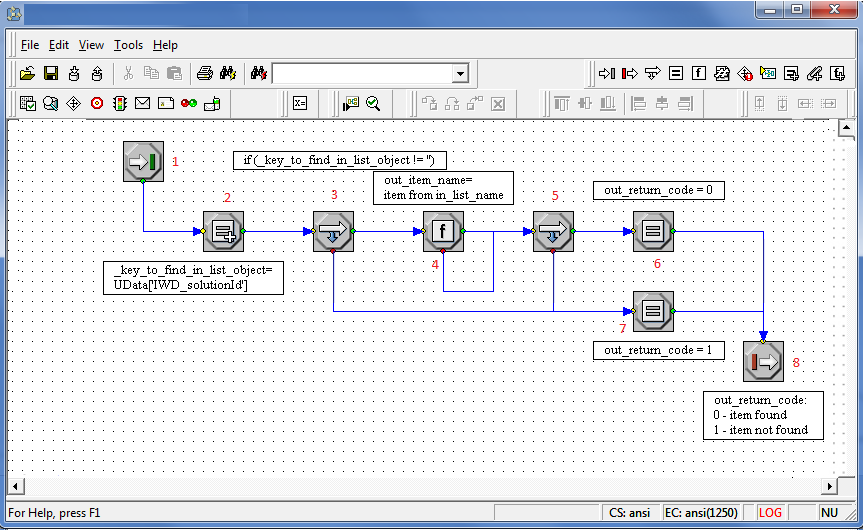Changes to IWDBP Strategies & Subroutines in 8.5.105
These topics describe changes made to the IWD Business Process for IRD in IWD release 8.5.105. Where strategies and subroutines are not referenced below, they remain the same as for release 8.5.104.
Classification Strategy
The purpose of this strategy is to invoke corresponding classification rules, analyze the result of the rules application and place the interaction into the appropriate queue, depending on the result.
This strategy processes interactions from the following queues:
- iWD_New—Interactions have to satisfy the following conditions:
- There are no conditions here.
- Interactions are taken in order they were submitted.
Changes in 8.5.105
Code has been refactored and removed to the InvokeGRE and InvokeUCS strategies in order to simplify them.
Flow Summary
Click to enlarge.
Flow Detail
- Entry to the Classification strategy.
- A command is sent to URS to use the interaction age while sorting interactions in internal queues.
- The InvokeUCS subroutine is invoked to create a new interaction in the UCS database.
- The InvokeGRE subroutine is invoked.
- Exit Classification strategy.
Prioritization Strategy
The purpose of this strategy is to invoke the corresponding prioritization rules, analyze the result of the rules application and place the interaction into the appropriate queue, depending on the result.
This strategy processes interactions from the following queues:
- iWD_Captured—Interactions have to satisfy the following conditions:
- Active interactions only (interactions which do not have the property IWD_activationDateTime set, or this property has a time stamp which is in the past.
- Interactions are taken in the order they were submitted.
Active Interactions only
- iWD_Queued—Interactions have to satisfy the following conditions:
- Interactions that are subject for immediate reprioritization (interactions that have the property IWD_reprioritizeDateTime set to a time stamp which is in the past)
- Interactions are taken in order of IWD_reprioritizationDateTime (oldest first).
For reprioritization
Changes in 8.5.105
Code has been refactored and removed to the InvokeGRE and InvokeUCS strategies in order to simplify them.
Flow Summary
Flow Detail
- Entry to the Prioritization strategy.
- The InvokeGRE subroutine is invoked.
- Exit Prioritization strategy.
Distribution Strategy
This strategy routes interactions to a requested Agent, requested Agent Group, requested Skill, or to the default iWD Agent Group, and can now process an IWD_Segment attribute from the segmentation settings.
This strategy processes interactions from the following queues:
- iWD_Queued—Interactions have to satisfy the following conditions:
- Interactions that are not subject for immediate reprioritization (interactions that do not have the property IWD_reprioritizeDateTime set, or that have this property set to a time stamp that is in the future).
- Interactions are taken in order of priority (highest priority first)
Changes in 8.5.105
Segmentation settings have been added to the ToDistribute View in the Distribution strategy, enabling it to make a call to the configured segments then add an IWD_Segment attribute to the interaction data. See the 8.5.105 diagram here and the feature description here.
Flow Summary
Flow Detail
- Entry to the Distribution strategy.
- Extract information about requested agent, agent group, or skill and initialize internal variables.
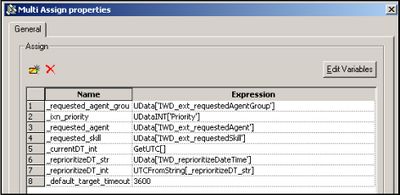
Multi-Assign - Requested Agent and Skill - A calculation is done to determine the timeout—how long the interaction should wait for a target to become available.
- If the reprioritize time was set up and the calculated timeout is less than or equal to the default timeout (1 hour, see Step 1), then the timeout remains as it is.
- If the reprioritize time was not set, or the calculated timeout is greater than the default timeout, then the waiting timeout is set to the default (1 hour).
- Analysis is done to determine whether an agent was requested.
- If an agent was requested, the URS variable is prepared (.a is added).
- Update the IWD_segment attribute to '_requested_agent'.
- Try to route the interaction to the requested agent without waiting.
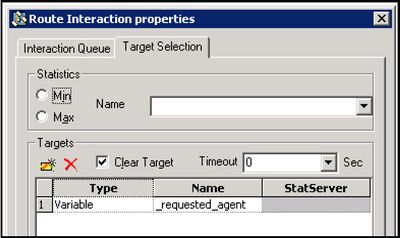
Route to agent - Update the IWD_segment attribute to '_requested_skill'.
- Try to route the interaction to an agent with the requested skill without waiting.

Route to Skill - Analysis is done to determine whether an Agent Group was requested.
- If an Agent Group was requested, the URS variable is prepared (.ga is added).
- Update the IWD_segment attribute to '_requested_agent_group'.
- Try to route the interaction to the requested Agent Group with wait time set to _waitTargetTimeout.
- Update IWD_segment attribute to '_default'.
- Try to route the interaction to the iWD agent group with a a wait time to _waitTargetTimeout.
- Get the last error.
- Verification is done as to why the target was not found.
- An error code is attached in case of any error other than a timeout. If more than one target is available, URS uses the StatAgentsLoading statistic to select the Agent who has the minimum load (this applies to routing to Skills and routing to Groups only; routing to a requested Agent does not use statistics). For more information about this statistic, see the Universal Routing 8.1 Reference Manual. The Route Interaction object also has an Interaction Queue tab. (This applies to all three Route Interaction objects in this strategy.)
Segmentation view
Route to Requested Agent Group
Route to Agent Group
Route Interaction Properties—Interaction Queue
The optional Interaction Queue tab enables you to specify two types of queues:
- Queues for existing interactions (the queue in which the interaction should be placed after the agent is done working with it).
- Queues for new interactions (the queue in which new interactions created by the agent should be placed).
A Description (optional) appears as a hint on the agent desktop as to where to place the interaction.
Invoke GRE Strategy
Changes in 8.5.105
Code has been removed from Classification and Prioritization strategies to the InvokeGRE strategy to simply the overall business process.
Flow Summary
Part 1
Part 2
Flow Detail
- Entry to InvokeGRE strategy.
- Check if in_method_name is set to SetBusinessContext or Prioritize.
- A variable is initialized—_delay_ms specifies the delay (in milliseconds) between attempts to invoke rules.
- The DetermineESPServerName subroutine is invoked to determine the name of the Genesys Rules Engine Application. The subroutine uses the List Object list GREServerList.
- If the subroutine was successful, a check is done to ensure the existence of the ESP server name that was returned by the subroutine. If the ESP server name was found, the flow goes to 10. The DetermineRulePackageName subroutine is invoked to determine the name of the rule package that the Genesys Rules Engine will be invoking to evaluate the classification rules.
- If the ESP server name was not found, this error is attached to user data as a key-value pair with the key IWD_GRE_Determination_Error.
- The interaction is placed in the iWD_ErrorHeld queue.
- If the subroutine fails an error is extracted.
- This error is attached to user data as a key-value pair with the key IWD_GRE_Determination_Error.
- Check if in_custom_package_name was published to this subroutine. If it is set then in_custom_package_name will be run. Otherwise package name needs to be found in Iwd_Package_List.
- Assign in_custom_package_name to _gre_package_name and set _return_code to 0.
- 11a. The DetermineRulePackageName subroutine is invoked to determine the name of the rule package that the Genesys Rules Engine will be invoking to evaluate the classification rules. If the rule package name was found, the flow goes to Step 16.
- If the rule package name was found, the flow goes to Step 16.
- If the rule package name was not found, this error is attached to user data as a key-value pair with the key IWD_Rule_Package_Determination_Error.
- If the subroutine fails an error is extracted.
- This error is attached to user data as a key-value pair with the key IWD_Rule_Package_Determination_Error.
- Delete IWD_reprioritizeDateTime from attached data.
- Check if in_method_name = SetBusinessContext.
- If in_method_name is set to SetBusinessContext then the process calls classification rules in GRE.
- If in_method_name is set to Prioritize then the process calls prioritization rules in GRE.
- An ESP request is sent to the Genesys Rules Engine to evaluate the classification rules.
- The ESP result is attached to user data as a key-value pair with the key IWD_GRE_Result.
- Check if IWD_reprioritizeDateTime was changed by rules.
- Delete IWD_reprioritizeDateTime from interactin if it was not changed by rules.
- Invoke CheckBusinessValueAndPriority subroutine to verify if IWD_businessValue and Priority have correct values.
- Check if in_method_name = Prioritize.
- Check if Priority was changed by rules in Prioritization.
- Attach IWD_Prioritization_Error to interaction with message Priority is not set up by rules.
- The interaction is placed in the iWD_Queued queue.
- An ESP request is sent to the Genesys Rules Engine to evaluate the prioritization rules.
- The last Interaction Server-related error is extracted from a variable.
- A check is done to see if the error code is related to the ESP server communication.
- The last error is attached to user data as a key-value pair with the key IWD_GRE_Error.
- Check if Department/Process is active.
- Check if business process was assigned.
- The interaction is placed in the iWD_Captured queue.
- The last error is attached to user data as a key-value pair with the key IWD_GRE_Error. If not, the value of the _counter variable is incremented by 1.
- A delay is introduced, based on the value of the _delay_ms variable. The flow goes back to 18 to retry the connection to the ESP server. The result from the ESP call to the Genesys Rules Engine is attached to the interaction as user data, with the key IWD_GRE_Result. This key-value pair will have the following format:
return:ok| NumberOfRulesApplied:<number of applied rules>| RulesApplied:<rule 1 id> <rule1 name>, <rule2 id> <rule2 name>, ...
The following example shows what the result might look like:
AttributeUserData [list, size (unpacked)=168] = 'ESP_Result' [str] = "return:ok|NumberOfRulesApplied:12| RulesApplied:McrSlt1GlbClsf1 McrSlt1GlbClassification1, McrSlt1GlbClsf2 McrSlt1GlbClassification2"
- The interaction is placed in the iWD_Captured queue.
- Exit InvokeGRE subroutine.
- The last error is attached to user data as a key-value pair with the key IWD_GRE_Error when in_method_name is not set to SetBusinessContext or Prioritize.
- The interaction is placed in the iWD_ErrorHeld queue.
- Exit InvokeGRE subroutine.
FindListObjectItem Subroutine
This subroutine amalgamates two subroutines that were previously separate in release 8.5.104:
- DetermineESPServerName
- DetermineRulePackageName
Flow Summary
Click to enlarge.
Flow Detail
- Entry to FindListObjectItem subroutine.
- Initialize variables:
- _key_to_find_in_list_object—Assign task IWD_SolutionId.
- out_item_name—Set its value to empty string.
- Check if _key_to_find_in_list_object is not empty.
- Search _key_to_find_in_list_object in in_list_name. Result will be assigned to out_item_name.
- Check if out_esp_name is empty.
- Set out_return_code to 0.
- Set out_return_code to 1.
- Exit FindListObjectItem subroutine



